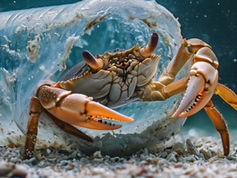Search
Phytoplankton (Not the SpongeBob Kind)
- Lauren A. Moe
- Dec 23, 2022
- 3 min read
Updated: Jul 7, 2023
Oceans and freshwater sources have many similarities and differences, but the core of their food webs remains the same: phytoplankton. Phytoplankton is food for the smallest animal-eating organisms in the water, such as zooplankton, crustaceans, and small fish. These animals are prey for bigger organisms, and the energy is transferred up the food web to organisms such as great white sharks, sea lions, dolphins, and even humans that eat fish. Filter feeders such as basking sharks, flamingos, and whales focus their energy solely on small organisms such as phytoplankton.
Fun fact: the name "phytoplankton" comes from the Greek words phyto, meaning plant, and plankton, meaning to wander or drift. These organisms live on the surface of the water and drift wherever the tides bring them.
Phytoplankton is microscopic plants that, like the trees around us, use sunlight as energy. Because they need light to survive, most live on the surface layer of the seas. These organisms are single-celled and therefore very small- ranging from 2-200 micrometers. As a frame of reference, a standard piece of printer paper has a height of 100 micrometers, and an average piece of human hair is only 70; dust mites average 250 micrometers. Phytoplankton comes in various shapes and sizes, the image below shows the five most common types.

Photo Source: Lindsey and Scott, 2010






Comments